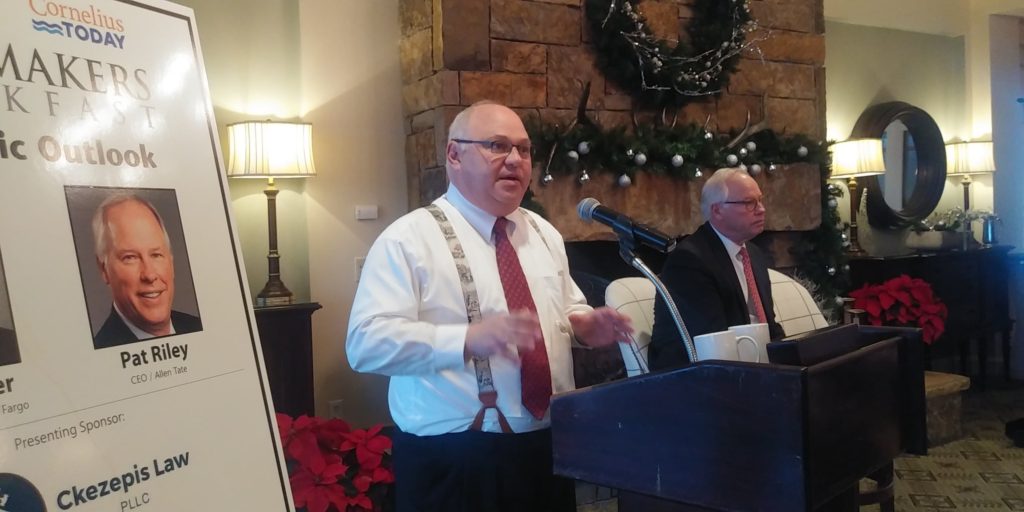
MARK VITNER AND PAT RILEY
By Erica Batten. Over the past decade, Raleigh and Charlotte have been among the top 10 fastest-growing metropolitan areas nationwide.
Wells Fargo Senior Economist Mark Vitner and Allen Tate President and CEO Pat Riley discussed regional and economic trends at a recent Newsmakers Breakfast hosted by Cornelius Today.
“Charlotte may be the fastest-growing metro area in the country; this ramped up over the last year,” said Vitner.
Charlotte recently reclaimed the rank as the nation’s second-largest banking city, home to Truist, the newly formed merger of BB&T and SunTrust, along with being a key employment base for Wells Fargo, Ally Financial and Dimensional Fund Advisors.
A Wells Fargo report noted that Charlotte is also growing as a tech hub, citing recent Microsoft and Lowe’s global technology center expansions. Charlotte has the nation’s highest growth of office rent, particularly in SouthPark and Ballantyne, along with the university and airport areas.
The value of Charlotte’s residential building permits remains among the highest in the nation. Vitner estimates that 150 people are moving to the Charlotte MSA every day.
Not surprisingly, the incoming population is young and college-educated. Vitner said the addition of a major league soccer team aligns perfectly with Charlotte’s vibe. And home prices—at just 1.8 times the average income—means the Queen City is competitively affordable compared to similar metro areas.
“We’re a place young people want to move to,” said Vitner.
Where the young people come, the parents follow, said Riley. Retirees prefer Charlotte’s South Carolina suburbs and submarkets within city limits. And, in many cases, they’re sharing the housing. Riley said that 30 percent of young people are still living at home.
But with interest rates at historic lows, rents at record highs, and two-thirds of millennial renters determined to buy a home, that trend may soon change.
“Home ownership is not an interest rate issue anymore. It’s an affordability issue,” said Riley.
The problem is, Baby Boomers are squatting on the inventory. And they’re not keeping it up-to-date, meaning that when retirees are ready to sell, buyers aren’t interested. The average Charlotte home is 43 years old. Homeowners should invest at least $10,000 annually in updating their homes in order to remain competitive in the market, Riley said.
But with the city’s new homes already 23 percent more expensive than they were a year ago, buyers may have to reconsider postponing a home purchase. Even with the steady growth of new residential permits, the supply of single-family homes struggles to keep up with demand.
Meanwhile, the city’s apartment vacancy rate of 7.4 percent is well above the national near-record low of 5.8 percent.
While the surge of multi-family home building has slowed nationwide, apartment development is shifting away from lifestyle and luxury units in a few metro areas toward more affordable units in suburban areas.
“In this decade, the suburbs are going to urbanize,” said Vitner.
As more and more people begin to call Charlotte and its suburbs home, consumer outlook may drive spending. Due in part to a normalized yield curve and equity markets at record highs, fears of an impending nationwide recession are beginning to ease.
“We don’t have any of the typical imbalances that come with recession,” said Vitner. “We didn’t buy too many cars; we didn’t build too many homes.”
Employment in North Carolina grew at 2% over the past year, making the Tar Heel State a standout in the southeast region. Only Florida’s employment grew faster.
This year, as part of an assessment of its monetary policy strategy and communications, the Federal Reserve Board conducted a series of “Fed Listens” events with workers around the country.
“What they were hearing more and more was that the economy has never been better for them at any time in their lifetime,” said Vitner.




